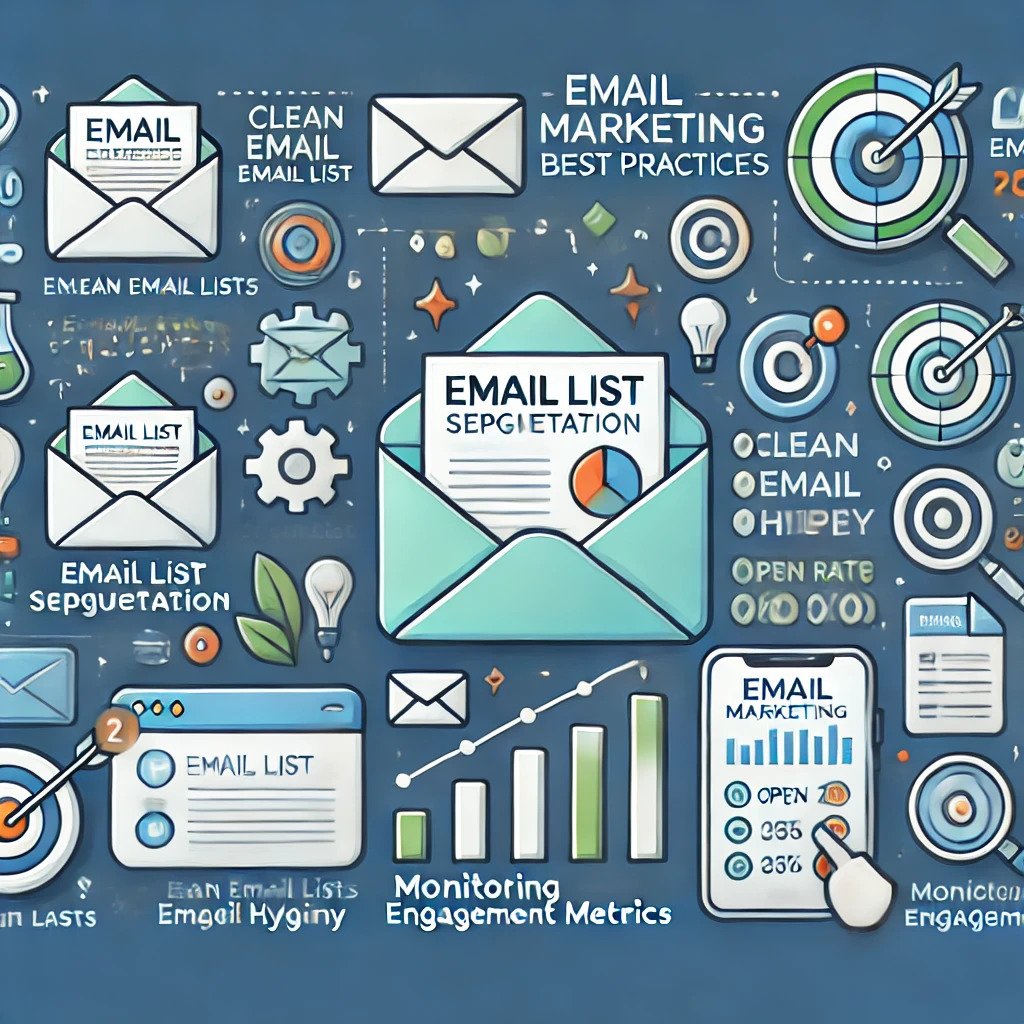Email marketing can be one of the most powerful tools for engaging customers and driving conversions. However, many businesses make common mistakes when managing their email lists that can hinder the effectiveness of their campaigns. These mistakes include failing to segment email lists effectively, neglecting list hygiene, and not monitoring engagement metrics.
Without proper segmentation, emails may become irrelevant to subscribers, leading to higher unsubscribe rates. Similarly, an unclean email list filled with outdated or inactive addresses can harm deliverability and campaign performance. Additionally, ignoring key engagement metrics prevents marketers from adjusting their strategies and optimizing for success. In this article, we’ll explore these common email list management mistakes and provide solutions to ensure your email marketing efforts are more effective and efficient.
Failing to Segment Your Email List Effectively

One of the most common mistakes businesses make in Email List Management is failing to segment their email list effectively. List segmentation is the process of dividing your email list into smaller, more targeted groups based on specific criteria, such as demographics, past behavior, or engagement levels. Without segmentation, your Email List Management efforts risk being too broad and irrelevant, leading to lower engagement, increased unsubscribe rates, and missed opportunities for conversions.
The Importance of List Segmentation for Personalized and Targeted Campaigns
Segmentation is a cornerstone of effective Email List Management. It allows you to deliver personalized, relevant content that speaks directly to the unique needs and interests of different subscriber groups. Personalized emails are more likely to be opened and acted upon than generic ones. By tailoring your messages to specific segments of your audience, you improve the chances of creating a stronger connection and boosting engagement.
For example, sending a special offer for winter clothing to a group of subscribers who have previously purchased jackets or scarves increases the likelihood of that offer resonating with them. On the other hand, failing to incorporate segmentation in your Email List Management could mean sending the same offer to your entire email list, including people who have no interest in clothing, likely causing the campaign to go ignored.
Moreover, targeted campaigns based on segmentation strengthen your Email List Management by increasing your return on investment (ROI). Relevant content leads to higher click-through rates, more conversions, and better customer retention. By segmenting your email list and targeting the right people with the right message, you ensure that your Email List Management resources are being used efficiently and effectively.
How Neglecting Segmentation Can Lead to Irrelevant Content and Higher Unsubscribe Rates
When Email List Management neglects segmentation, campaigns risk becoming irrelevant to many recipients. This is particularly problematic because subscribers who receive irrelevant content are more likely to disengage from your emails by either unsubscribing or marking them as spam. This leads to a reduction in your email list’s quality, affecting deliverability rates and engagement metrics.
For instance, if a retailer sends emails promoting a new line of baby products to their entire list, it’s likely that many subscribers who do not have children will find the email irrelevant. Poor segmentation in Email List Management could result in these recipients unsubscribing or ignoring future emails. Over time, continued irrelevant communication can damage your brand’s reputation and alienate potential customers.
Best Practices for Segmenting Based on Demographics, Purchase Behavior, and Engagement Levels
To avoid these issues, it’s crucial to refine your Email List Management with segmentation strategies based on key factors like demographics, purchase behavior, and engagement levels. Here are a few best practices to consider:
- Demographics: Segment your list based on factors such as age, gender, location, or job title. For instance, a clothing brand might send different campaigns to men and women or to customers in different geographic locations, tailoring offers to each group’s specific preferences. This tactic ensures that your Email List Management is relevant and impactful.
- Purchase Behavior: Segmenting by purchase history allows you to send targeted offers based on past buying patterns. For example, you could create segments for repeat customers, first-time buyers, or cart abandoners and send them tailored offers or reminders. Effective Email List Management thrives on such detailed segmentation.
- Engagement Levels: Segmenting based on how engaged subscribers are with your emails can help you target inactive subscribers with re-engagement campaigns, while nurturing your most active customers with exclusive offers or VIP content. This nuanced approach is vital for successful Email List Management.
By implementing these segmentation strategies as part of your Email List Management, you can ensure that each subscriber receives relevant and engaging content, which increases the likelihood of maintaining an engaged, loyal customer base. Email List Management is key to creating campaigns that resonate with your audience and deliver measurable results.
Ignoring Email List Hygiene and Regular Cleaning

Maintaining a clean email list is one of the most crucial aspects of successful email marketing, yet it is often overlooked. Regularly cleaning your email list and practicing good list hygiene are essential for improving deliverability, maintaining engagement, and ensuring that your email campaigns run smoothly. Failing to keep your list updated can lead to several issues that negatively impact your overall email marketing efforts.
How Outdated or Inactive Email Addresses Can Harm Deliverability Rates
One of the primary reasons for regular email list cleaning is to remove outdated or inactive email addresses. When your email list contains a significant number of invalid or non-engaging addresses, it can cause your email deliverability rates to drop. Email providers like Gmail, Yahoo, and Outlook monitor user engagement closely. If they notice that a significant portion of your emails are being ignored or returned as undeliverable, they may flag your emails as spam or even block them from reaching your subscribers’ inboxes altogether.
Additionally, maintaining a list full of outdated or inactive addresses can lead to high bounce rates. A high bounce rate signals to email service providers (ESPs) that your list might not be maintained properly, resulting in reduced sender reputation. A damaged sender reputation can make it more difficult for your future emails to land in inboxes rather than spam folders, ultimately hurting your campaign’s effectiveness.
The Risks of Not Regularly Cleaning Your Email List
Neglecting to clean your email list regularly can result in several negative outcomes, including high bounce rates, spam complaints, and decreased engagement. When you send emails to invalid or non-engaging addresses, not only are you wasting your resources on unresponsive recipients, but you are also jeopardizing your email deliverability.
For example, if an email is repeatedly sent to inactive or invalid addresses, it increases the chances of your emails being flagged as spam by ESPs. Additionally, if a recipient marks your email as spam because it’s irrelevant or unwanted, it can have long-term consequences on your sender reputation and hurt future email campaigns. This becomes a vicious cycle that only worsens over time, leading to further reductions in email deliverability and overall campaign effectiveness.
Steps to Maintain a Clean and Engaged Email List
To avoid these issues, it’s vital to implement effective list hygiene practices. Here are a few steps to maintain a clean and engaged email list:
- Use Double Opt-In: Implement a double opt-in process, where subscribers confirm their subscription through an email verification link. This ensures that the email addresses you add to your list are valid and actively engaged with your brand.
- Remove Inactive Subscribers: Regularly review your email list and remove subscribers who haven’t engaged with your emails in a long time. This can be done by analyzing open and click-through rates to identify inactive users. You can even run re-engagement campaigns to try and win back these subscribers before deciding to remove them.
- Monitor Bounce Rates: Keep a close eye on your bounce rates, and take action to remove hard bounces immediately. Soft bounces may be temporary, but if they continue, consider removing or re-validating those email addresses.
- Use Email Validation Tools: Consider using email validation services to regularly check and clean your list. These tools can help identify invalid or disposable email addresses, ensuring that your list stays up-to-date and your campaigns reach the right audience.
By consistently maintaining a clean email list, you ensure better deliverability, fewer spam complaints, and ultimately, more successful email marketing campaigns. Regular list cleaning may seem like a time-consuming task, but it’s a critical investment that will pay off by improving your sender reputation and overall email marketing performance.
Not Monitoring Engagement Metrics and Adjusting Your Strategy

Monitoring engagement metrics is essential for optimizing your email campaigns and ensuring they deliver the best results. Effective Email List Management depends on tracking key performance indicators (KPIs) such as open rates, click-through rates, and conversion rates. By neglecting these, businesses can miss valuable insights necessary for improving their efforts.
The Importance of Tracking Open Rates, Click-Through Rates, and Other Key Metrics
Metrics like open rates, click-through rates (CTR), and conversion rates provide insights into how well your campaigns resonate with your audience. Open rates show how many recipients engage initially, which is vital for Email List Management. If open rates are low, it signals potential issues with subject lines or audience targeting.
Click-through rates, measuring how many recipients click links, indicate the content’s relevance and quality. A low CTR reflects missed opportunities in engaging with your Email List Management strategy. Conversion rates track actions like purchases or sign-ups, highlighting how well your offers align with audience interests.
How Failing to Monitor Engagement Can Lead to Decreased Performance Over Time
Without monitoring metrics, businesses risk sending irrelevant content, hurting their Email List Management efforts. For instance, ignoring low engagement metrics can result in audience fatigue and higher unsubscribe rates. Over time, this neglect damages sender reputation and email deliverability.
Adjusting Your Email Strategy Based on Data to Improve List Management and Campaign Success
Success hinges on using data-driven insights for refinement. Low open rates? Experiment with subject lines or timings. Poor CTR? Test different CTAs or content. Data trends allow for better audience segmentation, a cornerstone of Email List Management. By creating tailored campaigns for responsive segments, you improve engagement and performance.
Monitoring metrics also helps identify inactive subscribers, crucial for efficient Email List Management. Removing or re-engaging these users maintains a high-quality list, ensuring emails reach interested recipients. Consistent analysis and adjustments safeguard the effectiveness of your email campaigns.
Conclusion
In conclusion, managing your email list is a critical component of successful email marketing campaigns. By avoiding the mistakes of poor segmentation, neglecting list hygiene, and failing to monitor engagement metrics, you can significantly improve the performance of your campaigns. Properly segmented lists lead to more personalized, relevant content that resonates with subscribers, while regularly cleaning your list ensures better deliverability and engagement. Additionally, actively tracking engagement metrics allows you to refine your strategy and continuously improve your results. By implementing these best practices, you’ll not only enhance your email marketing effectiveness but also build stronger, long-lasting relationships with your audience.

